Eggplant is one of the vegetables that can become a staple in your everyday cooking. Brinjal is a versatile crop that can be grown in various agro-climatic conditions. Brinjal is an Asian vegetable native to India that belongs to the Solanaceae family. Throughout the year, it can be grown. In addition to Egypt, France, Italy, and the United States, it is also popular in other countries. Compared to other vegetables, Brinjal is a hardy crop.
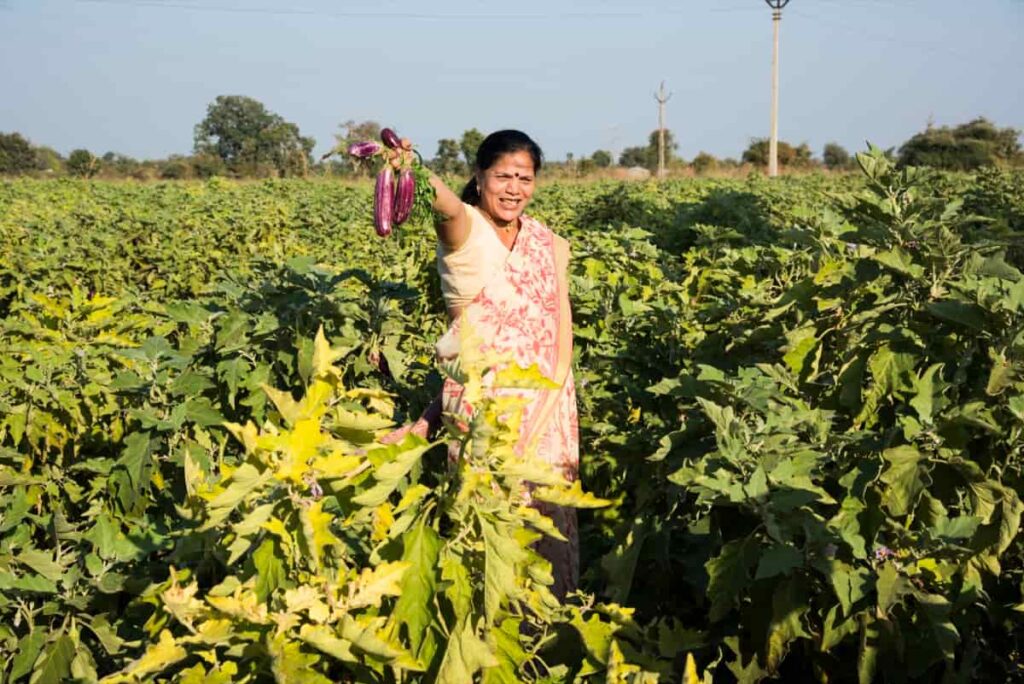
Due to its hardness, it can be grown in a dry area without adequate irrigation facilities. As a result, vitamins and minerals are moderately abundant in them. The growing season is all year round. India produces Brinjal in second place after China. Brinjal grows mostly in India in West Bengal, Orissa, Karnataka, Bihar, Maharashtra, Uttar Pradesh, and Andhra Pradesh.
Profitable organic Eggplant/Brinjal cultivation in West Bengal
How does West Bengal government support organic farming
In view of the increasing demand for the organic agricultural product, Government has been promoting Organic farming as chemical-free farming through dedicated schemes, namely Paramparagat Krishi Vikas Yojana (PKVY) and Mission Organic Value Chain Development for North Eastern Region (MOVCDNER) since 2015-16.
In case you missed it: How to Grow Eggplants in Raised Beds: Step-by-Step Guide to Planting and Care
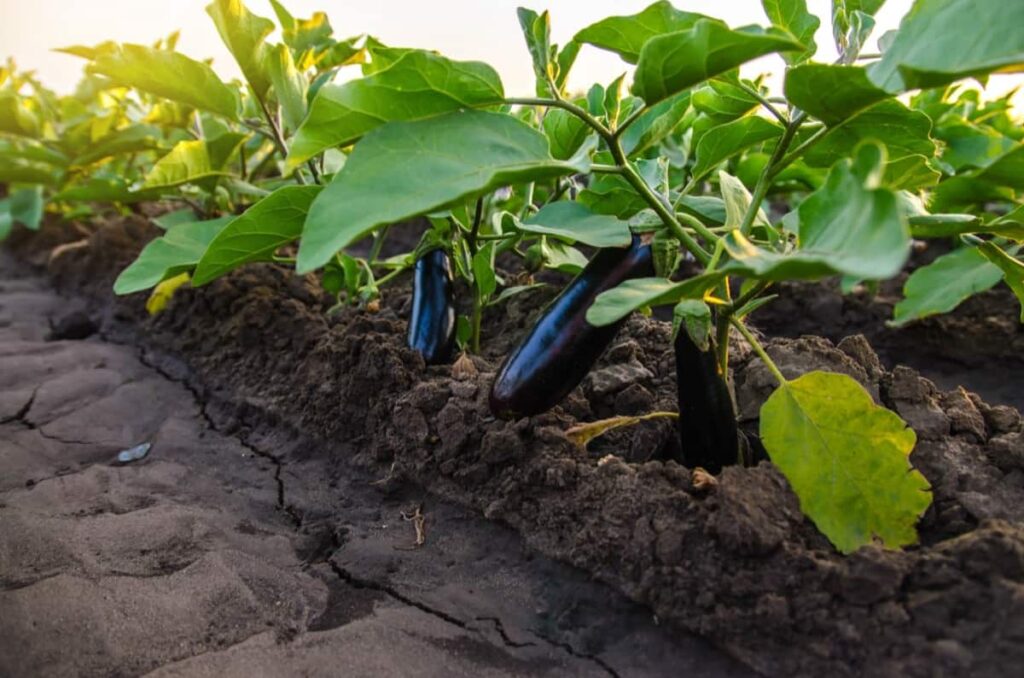
Both schemes support organic farmers from organic production to certification and marketing, including post-harvest management like processing, packaging, etc. Under PKVY & MOVCDNER schemes, farmers are provided financial assistance of Rs 12000/ acre / 3 years and Rs 13000/ acre/3 years, respectively, for organic inputs such as seeds, bio-fertilizers, bio-pesticides, organic manure, compost/vermicompost, botanical extracts, etc.
In addition to the above, support is also provided for group/ Farmers Producers Organization (FPO) formation, training, certification, value addition, and marketing of organic produce. Under BPKP, financial assistance of Rs. 5000/acre for three years is provided for cluster formation, capacity building, and continuous handholding by trained personnel, certification, and residue analysis.
Brinjal varieties
Long Varieties
Pusa purple long
It is a variety that is extra early. The plant is ready for harvesting about 75-80 days after sowing during the autumn-winter season and 100-110 days during the spring-summer season. The plant becomes ready to pick after transplanting in about 45 days. It is medium in height and has a semi-erect and bushy habit. Fruits are long, slender, purple, glossy, and 25-25 cm long, prone to drowning and touching the ground. An acre of land yields 120 quintals on average.
In case you missed it: How to Start Brinjal Farming/Eggplant in West Bengal: Planting to Harvesting Guide for Beginners
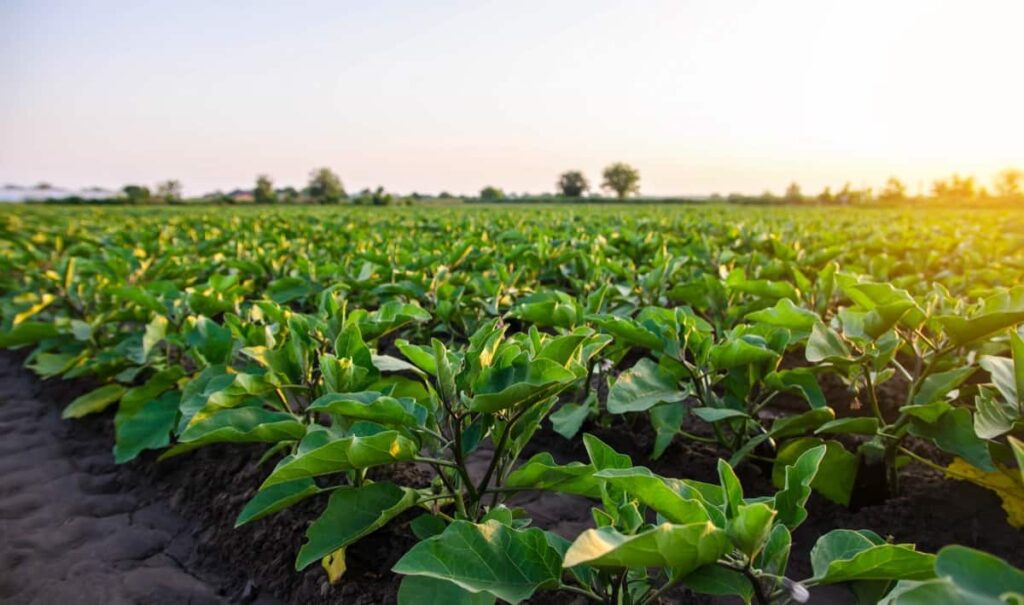
Pusa purple cluster
IARI, New Delhi, developed this medium-early variety. The fruits are 10-12 cm long, deep purple, and borne in clusters of 4-9. It is suitable for southern and northern hills and is moderately resistant to bacterial wilt. A 75-day harvest is possible for this variety, with an average yield of 70 quintals per acre.
Pusa Hybrid-5
It is a vigorous plant with semi-erect branches, non-spiny, and non-hairy. With partially pigmented peduncles weighing about 100 grams, the fruits are long, glossy, attractive, and dark purple. After sowing, it takes 80-85 days for the first crop to be picked. Having an average yield capacity of 200 quintals per acre, it is an early hybrid and a high yielder.
Round Verities
Pant Rituraj
It is a derivative of T-3×PPC from Pantnager. Its fruits are almost round, attractive purple in color, soft, less seeded, and endowed with good flavor. The average yield is 160 quintals per acre. It possesses field resistance to bacterial wilt.
In case you missed it: How to Start Eggplant/Brinjal Farming in Malaysia: Check How this Guide Helps to Grow Eggplant
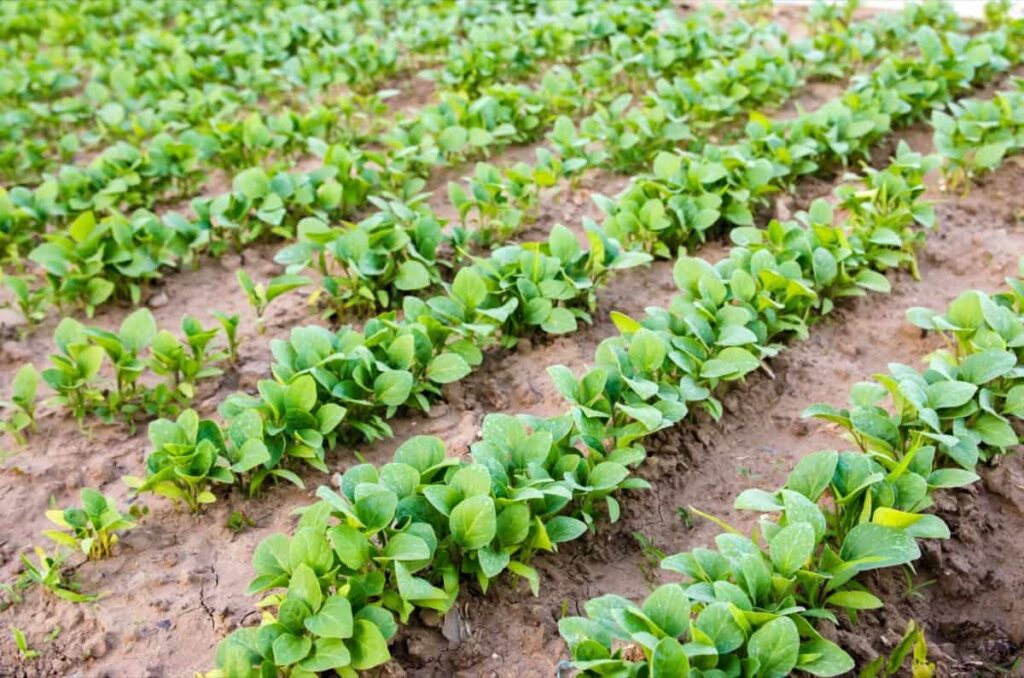
Arka Kusumaker
This variety is an improvement compared to Karnataka’s local collection (IIHR-193). The fruit is small, long, borne in clusters of 5 to 7, has a good texture and cooking qualities, and has light green skin. On average, 120 quintals are produced per acre.
Arka Navneet (F1)
It is a cross between IIHR 22-1×Supreme from Bangalore. Fruits oval- round and free from bitterness. Fruit skin is attractive, deep purple, soft flesh, and with few seeds. Yield is 260 – 280 quintals per acre.
Pusa Uttam
Plants are semi-upright, vigorous, well-branched, and spine-free. A mature plant appears green with occasional light pigmentation on growing shoots. Clusters of flowers are present. A pendant fruit has an oval shape, a large size, a glossy surface, and pale purple skin with a green peduncle. Each fruit weighs between 250 and 300 grams, and the bearing habit is solitary. On average, 160 quintals are produced per acre.
Soil requirement for cultivating Brinjal
Brinjal is a hardy crop that can be grown on different types of soils. Crops grown on well-drained sandy loam soil that produces good yields and are long-term crops require well-drained fertile soil. For early crop light, the soil is good, and high-yield clay loam and silt loam are suitable. For good growth pH of the soil should be 5.5 to 6.6.
In case you missed it: Best Practices to Grow Brinjal/Eggplant at Home: Check How this Guide Helps Beginners
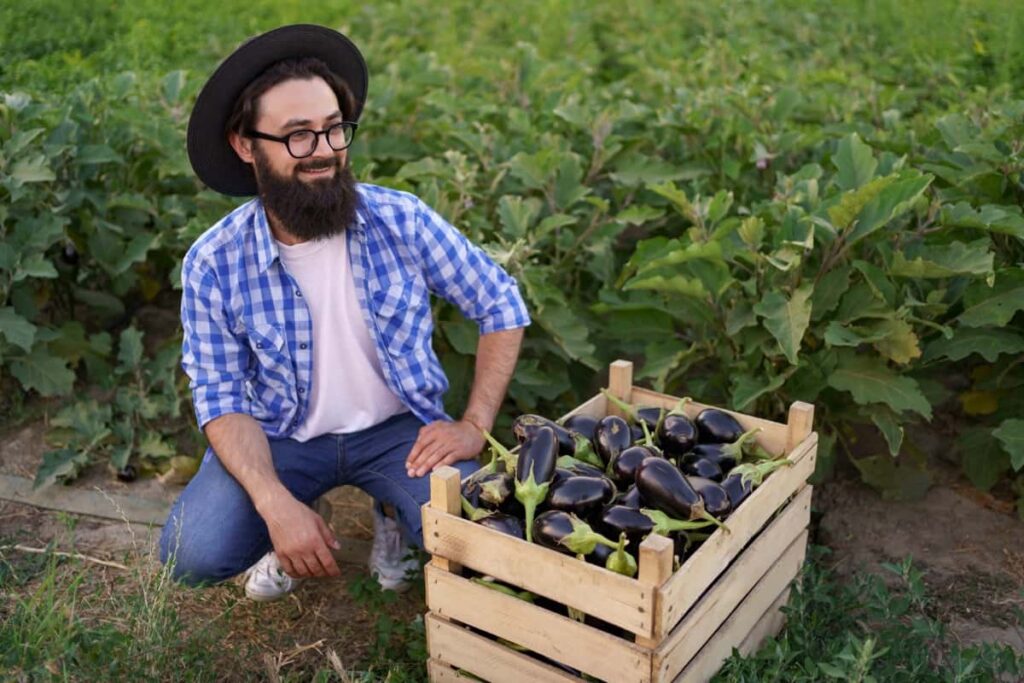
Climate requirements for cultivating Brinjal
Brinjals need a long and warm growing season because they are a warm-season crop. There is a high risk of frost damage. Temperatures between 13-21°C are most favorable for its successful production. The crop’s growth is severely affected when the temperature drops below 17°C. It can be grown successfully at an elevation of 1200 m above sea level during the rainy and summer seasons.
Seasons for planting Brinjal crop
It can be grown throughout the year in plains, but rabi season is the best time to grow it.
- Rainy season – June to July
- Winter season – October to November
- Summer season – February to March
Seed Rate & seed treatments
- Seed rate: 1-2 kg per acre.
- The seeds should be treated with azospirillium at a dose of 40 grams per 400 grams, and rice gruel should be used as glue.
- Sow the seeds 24 hours after treatment with four grams/kg of Trichoderma viride or ten grams/kg of Pseudomonas.
- To maximize seed germination and seedling vigor, soak the seeds in 12% raw cow’s milk (120 ml in 880 ml of water). It also increases the speed of germination.
- For 30 minutes before sowing, soak seeds in a solution of cow’s urine (1 part urine + 5 parts water). As a result, seed-borne diseases such as fruit rot and dieback will be inhibited.
- Before sowing, seeds should be bundled in a cotton cloth and soaked in a biogas slurry for 12 hours. As a result, it will kill all disease-causing microbes and increase the seeds’ vigor.
- For healthy seedlings, soak brinjal seeds in 2% Panchagavya (20 ml Panchagavya in 980 ml water) for 30 minutes before sowing.
In case you missed it: West Virginia Vegetable Planting Calendar: Month-wise Chart, Dates Guide, Schedule for Fall, Winter, Spring, and Summer Seasons
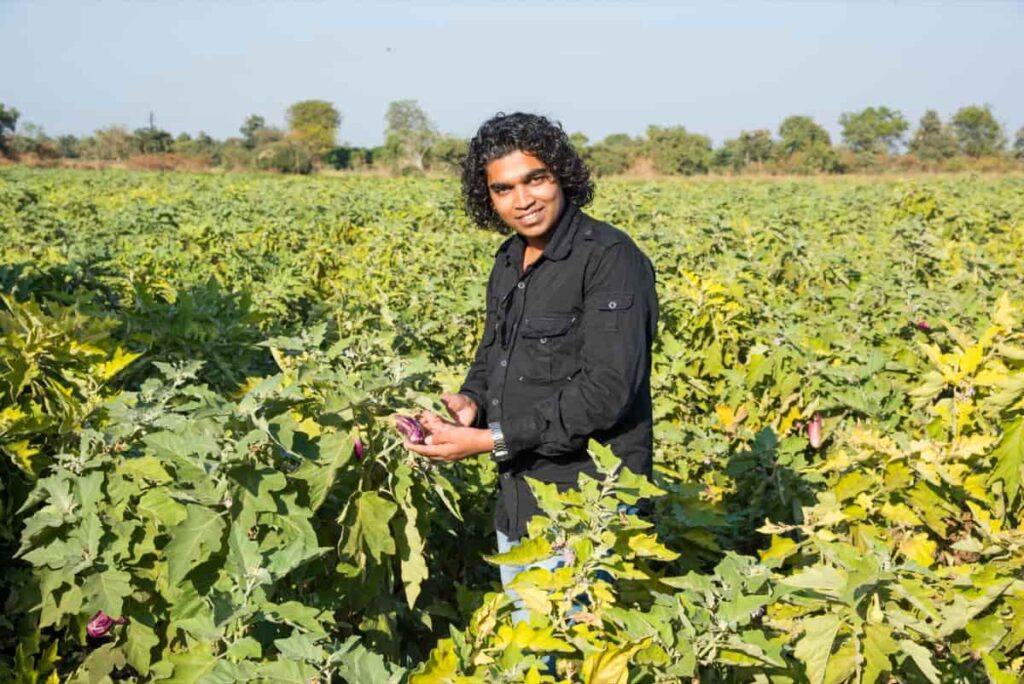
Bed preparation and sowing of Brinjal seeds
In nursery beds, brinjal seeds are sown to raise seedlings for transplantation. In heavy soils, raised beds are necessary to prevent water logging. However, flatbeds can be used for sowing in sandy soils. Thus, raised beds with dimensions of 7.2 x 1.2 m and a height of 10-15 cm are prepared. A one-acre area can be planted with seedlings raised in four such beds. Watering, weeding, etc., is carried out between two beds at about 70 cm distance.
Beds should have a smooth and level surface. As part of the bed preparation, mixing well-decomposed farm yard manure or leaf mold with the soil is possible. A thin line of seed should be sown at a distance of 5-7 cm. Sow the seeds at a depth of 2-3 cm, cover them with soil, and water lightly with a water can. Covering the beds with straw, grass, or sugarcane leaves will help maintain the required temperature and moisture.
The water should be applied as needed until germination has been completed using water can. After germination, dry straw or grass is removed. Hardening seedlings in the nursery may be accomplished by withholding water slightly during the last week. When the seedlings reach 15 cm tall with 2-3 true leaves, they are ready for transplantation within 4-6 weeks.
Planting Brinjal seedlings in the main field
Land preparation
By giving the field four to five plowings with a sufficient interval between each plowing, the field is plowed to a fine tilth. Then, for proper leveling, planking should be done. After that, the field is divided into beds and channels. Land preparation includes thoroughly incorporating decomposed FYM.
Transplanting seedlings
Depending on the variety grown and the planting season, spacing varies. A 60 x 45 cm spacing is usually used for long-fruited varieties, 75 x 60 cm for round varieties, and 90 x 90 cm for great-yielding varieties. If the soil is light, seedlings are transplanted in furrows, while if the soil is heavy, they are transplanted along ridges. 3-4 days before transplanting, pre-soaking irrigation is given. Therefore, transplanting should ideally be done in the evening.
Organic fertilizers application in Brinjal cultivation
The fertilizer dose is determined based on the soil fertility, and the amount of organic manure applied to the crop. To ensure a good yield, the soil is amended with 15-20 tons of well-decomposed farm yard manure. During the flowering stage, Fish ensilage (Meen amilam, is prepared by mixing equal ratios of fish waste and jaggery in a plastic barrel and kept for 21 days for fermentation with stirring) it is given at 250 ml/tank to prevent flower shedding and also to repel pests. Vermicompost and Neem cake is applied to each plant in the opposite direction to enhance the soil fertility and to control the nematode and soil pathogen pests.
In case you missed it: How Do You Grow Cucumbers in a Greenhouse: A Step-by-Step Guide for Beginners
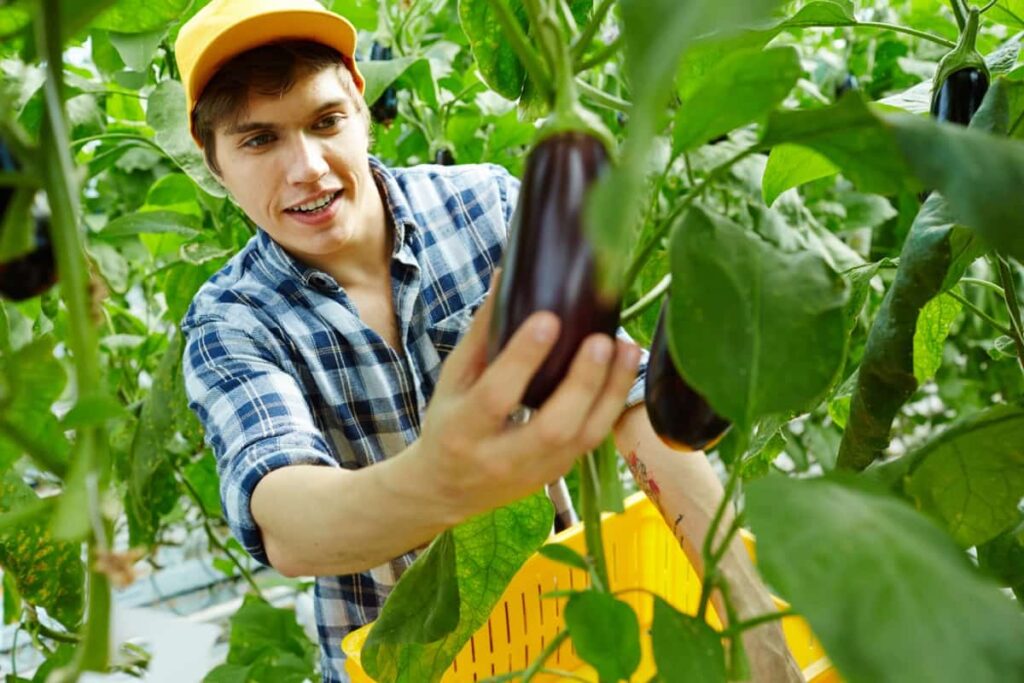
Water requirements and irrigation systems in Brinjal cultivation
Generally, the proper irrigation plan for brinjal plants is to apply 2.5-5cm of water (1-2 inches per week). Of course, water requirements can be different under different weather and soil conditions. For example, heavy clay soils normally need less irrigation than sandy soil. On the other hand, a dry day with high temperatures may require more than one irrigation session. Different eggplant varieties also have different water requirements.
Watering the foliage has been linked with disease outbreaks. Excess humidity, especially on foliage, may favor disease outbreaks. On the other hand, water-stressed plants are more susceptible to diseases. The most commonly used irrigation system is drip irrigation. Most producers use multiple or one–use drip strips with a 20 cm (7.8 inches) distance between drips.
Pruning in Brinjal crop
Prune your Brinjal plants early, so a leaf canopy forms before fruiting to prevent sunburning the fruit. Then, continue to prune Brinjal plants periodically or severely throughout the growing season if production drops for a new flush of leaves and flowers. Prune staked Brinjal to three branches using a sharp, clean pair of hand shears.
After the Brinjal begins to flower, clip the lower leaflets from the main branch. Removing these leaves boosts air circulation and allows light to penetrate the canopy. Continue to prune away suckers throughout the growing season to boost plant vigor and increase food production.
Major pests in Brinjal crop and their organic control
Shoot and fruit borer
Damage symptoms
- The withering of terminal shoots/dead hearts
- Boreholes on shoots and fruits plugged with excreta
- Shedding of flower buds
- Withering and drying of leaves
In case you missed it: Growing Pomegranate Organically in Maharashtra: Farming Practices and Production Guide
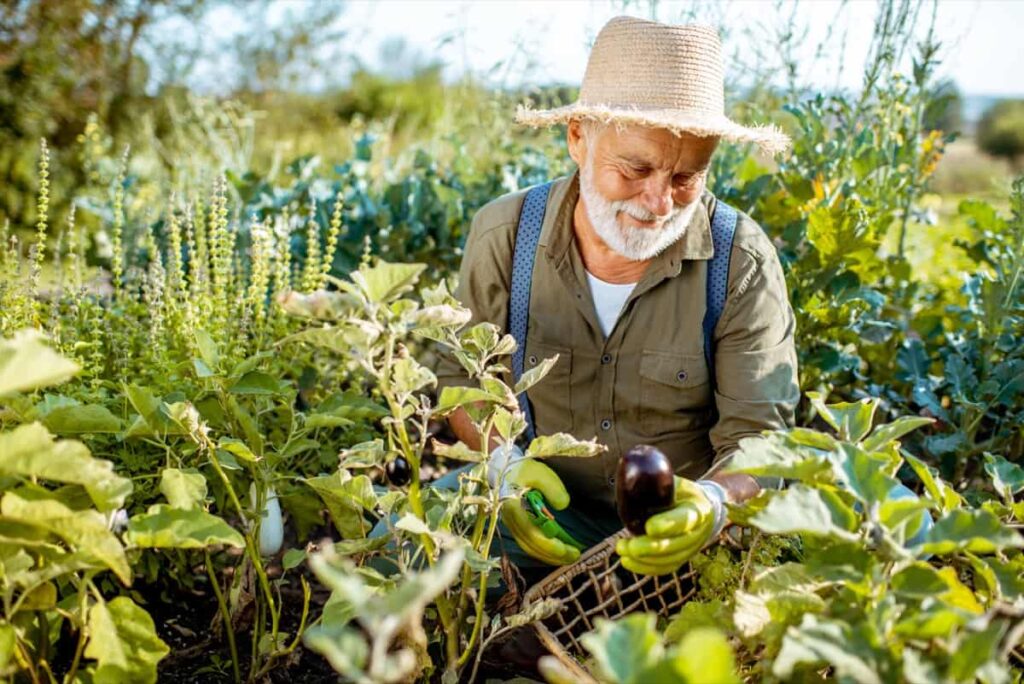
Control and management
- Remove the affected terminal shoot showing boreholes.
- Grow the varieties with long and narrow fruits in endemic areas
- Install pheromone trap at 5/acre
- Encourage the activity of larval parasitoids: Pristomerus testaceous, Cremastus flavoorbitalis
- Spray Neem Seed Kernel Extract 5 %
Stem borer
Damage symptoms
- Top shoots of young plants droop and wither.
- Older plants become stunted.
- Fruit bearing is affected
Control and management
- Collect and destroy the damaged and dead plants
- Light trap at 1/acre to attract and kill adults
- Spray neem oil 2 ml/lit
- Avoid using synthetic pyrethroids, causing the resurgence
Red spider mite
Damage symptoms
- Larvae, nymphs, and adults feed on the under surfaces of leaves.
- Affected leaves gradually start curling and finally shrivel.
Control and management
Sprays derived from natural sources, like neem oil and horticultural oil, can kill mites on contact. Infestations of spider mites should be treated every three days until control has been achieved.
Major diseases in Brinjal crop and their organic control
Phomopsis blight and fruit rot
Damage symptoms
- The disease appears as circular brown spots on the leaves.
- The fruit develops pale, sunken spots later, which enlarge and cover the entire surface of the fruit. Finally, the internal part of the fruit rots away.
Control
- Destroy infected plant material to reduce levels of inoculum.
- Plant-only disease-free seed and clean transplants
- Applications of appropriate organic fungicides may be required to control the disease.
In case you missed it: The Importance of Soil Health in Farming: Role of Soil in Sustainable Agriculture
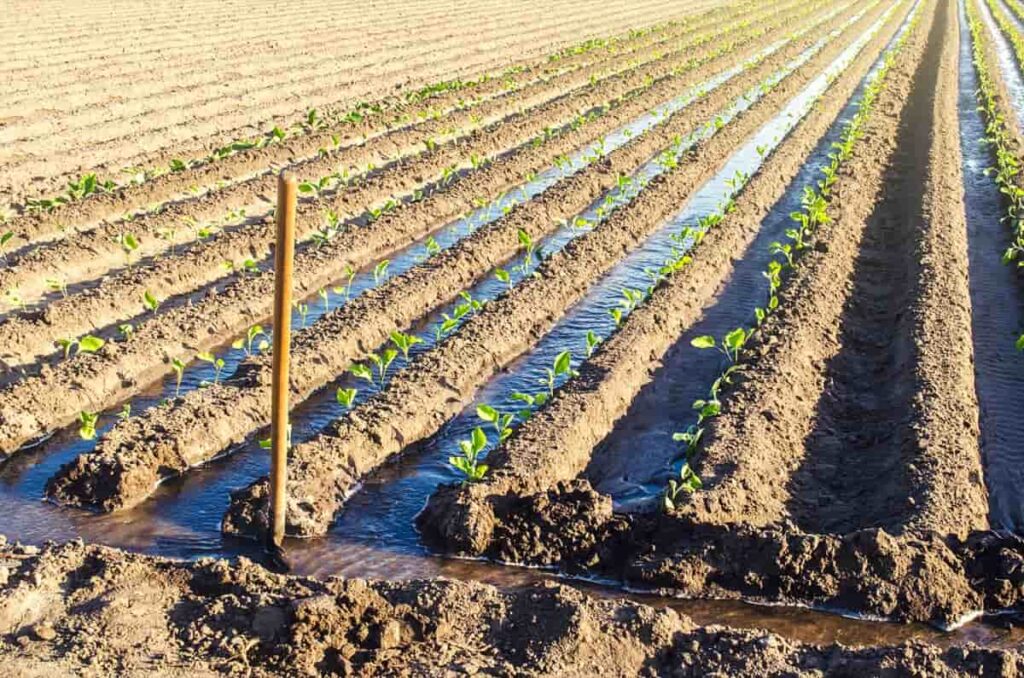
Sclerotinia blight
Damage symptoms
- Downwards wilting of twigs occurs from the top towards the main stem.
- Fungal growth occurs near joints in severe cases—finally, the whole plant wilts.
Control
- Rotate crops away from susceptible plants for two years if the disease is present.
- Avoid excessive overhead irrigation and only plant in well-draining soils.
Harvesting Brinjal crop
The fruits are ready for first picking in about 120-130 days after seed sowing. Fruits should be harvested as soon as they reach a good size and color. Fruits are harvested when their flesh turns dry and tough and turns greenish-yellow or bronze. A fruit’s maturity can be determined by pressing the thumb against its side. The fruit is too immature when the pressed portion springs back to its original shape. The fruit’s stem end and some of the calyx are left on the fruit after harvesting. All fruits do not mature simultaneously, so they are harvested at 8-10 days intervals.
Conclusion
In West Bengal, the Brinjal can be grown around the year, the main sowing from July to August. Brinjal crop is yielded after around 175 days from sowing. The state of West Bengal does around 8.4% of total brinjal production. In West Bengal, every year, the yield of the brinjal crop varies from around 3 to 5 tons, depending on the variety of hybrid seeds used by the farmer.
- How to Raise Pigs in Your Own Backyard: A Comprehensive Guide
- Budget Friendly Sheep Shed Ideas: Cheap and Low-Cost Tips
- How Much Do Cattle Farmers Make: Revenue Streams in Cattle Farming
- Management Pests and Diseases in Your Cotton Field
- Sheep Farming Business Plan for Beginners
- Aquaponic Farming at Home: A Step-By-Step Guide
- Profitable Village Farming Business Ideas in 2024
- High-Yield Aquaculture: Fast-Growing Fish for Farming
- Effective Fish Pond Construction Techniques for Beginners
- Irrigation and Water Management in Pineapple Farming
- Blossom to Harvest: Mastering Flowering and Pollination in Papaya Farming
- Pig Fattening Essentials: From Selection to Sale for Beginners
- Raising Wagyu Cattle: A Complete Guide for Premium Beef Production
- Soil Types and Their Water Holding Capacity
- Optimizing Irrigation Schedules for Coconut Groves for Enhanced Yield
- Espresso Your Garden: Coffee Grounds for Healthier Acid-Loving Plants
- The Best Soil Mix for Snake Plants: How to Mix Your Own Snake Plant Soil
- Green Thumb Success: Expert Tips for Cultivating Greenhouse Beans All Year Round
- Bloom All Year Round: The Ultimate Guide to Indoor Hyacinth Care
- Eco-Friendly Gardening: How to Make Liquid Fertilizer from Kitchen Waste
- Ultimate Guide to Grow Anise in Pots: Explore Seed Propagation to Harvesting
- Guide to Raising Chester White Pigs: Discover Breed Facts to Growth Management
- Mastering the Elegance: The Ultimate Guide to Weeping Cherry Tree Care, Planting, and Maintenance
- Ultimate Guide to Planting Garlic in Grow Bags: Growing Strategies for Beginners
- How to Fix Spider Plant Leaf-Related Problems: Natural and Organic Remedies
- 10 Reasons Why Your Tulsi Plant is Shedding Leaves: Home Remedies and Solutions
- Optimizing Growth and Yield: The Advantages of Palm Bunch Ash Fertilizer
- Utilizing Neem Oil Extract as a Natural Pesticide for Hydrangea
- From Soil to Harvest: Various Ways in Which Farmers Can Use AI Tools
- Steps to Encourage and Induce Citrus Flowers: A Comprehensive Guide
- How to Fix Snake Plant Leaf-Related Issues: Natural and Organic Remedies
- Transform Your Garden into a Fragrant Oasis with Raat Ki Rani (Night Blooming Jasmine)
- Discover the Ideal Chicken Breeds for Philippine Farms
- How to Create a Poultry Egg Farm Business Plan for Profits
- Grow Lemon Cucumbers Like a Pro: Insider Techniques for Bountiful Yields
- Ultimate Guide to Caring for Your Pink Princess Philodendron: Tips for Thriving Variegation
